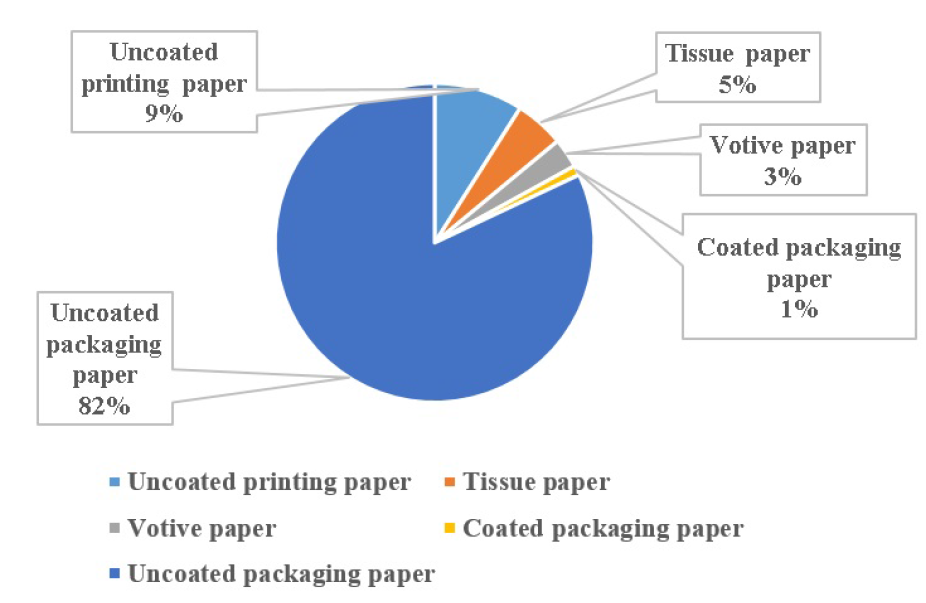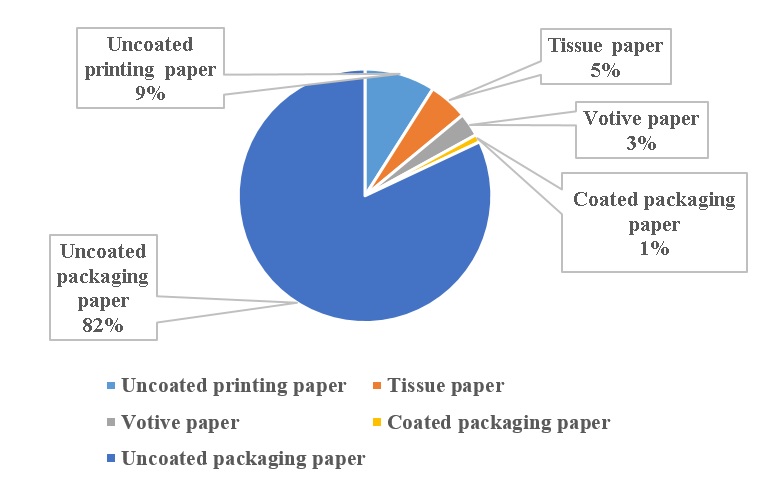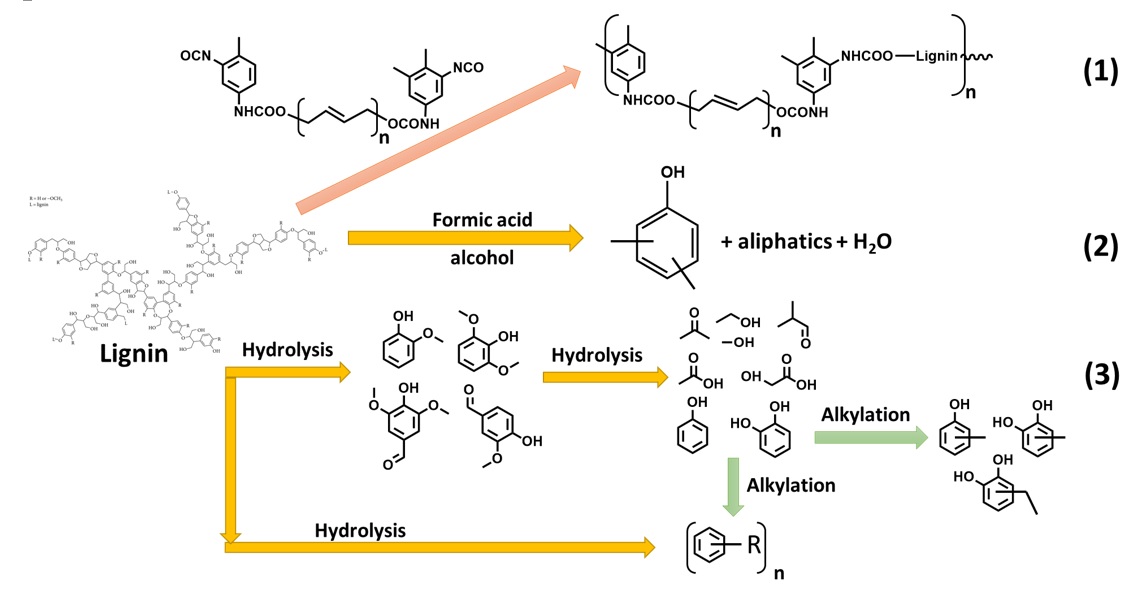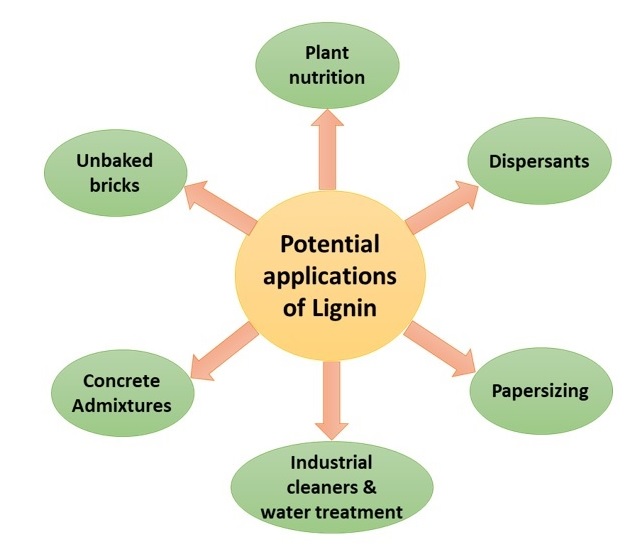
Potential applications of waste lignin from the paper and pulp industry in Viet Nam
- Department of Chemical Engineering, School of Biotechnology, International University, Ho Chi Minh City, Vietnam
- Industrial Development Center of Southern Vietnam, Ministry of Industry and Trade, 12 Nguyen Thi Minh Khai street, District 1, Ho Chi Minh City, Vietnam
- Department of Environmental Engineering, International University, Ho Chi Minh City, Vietnam
Abstract
The conversion of waste lignin from the paper and pulp industry is a potential process to produce chemicals and materials in the industry. With the development and the demand for the pulp and paper industry, the amount of waste lignin will increase remarkably. In Vietnam, the forest tree for the pulp industry is abundant, and the pulp industry has increased in recent years. In parallel, the government planned to develop the material resource and high-tech factories for this industry. In this work, we summarized the pulp and paper industry in Vietnam, then suggest the potential applications of waste lignin in several valuable products.
Introduction
Lignin is a by-product of the pulp and paper industry, and it can be considered as a renewable material coming from lignocellulosic feedstock. In the industry, technical lignin can be classified by the lignin production processes (
Looking at the chemical view, lignins have aromatic backbones 4, making them an ideal renewable feedstock of aromatic compounds for a range of applications, including automotive brakes, wood panel products, surfactants, phenolic resins, phenolic foams, biodispersants polyurethane foams, and epoxy resins 5, 6, 7, 8, 9, 10. In fact, native lignin is a heterogeneous polymer with the phenylpropane unit (C9-unit) of the p-hydroxyphenyl (H), guaiacyl (G) and syringyl (S) types 4, 11. The C9 units are linked to form lignin with C−O—C and C−C linkages (Figure 1), and the most abundant linkage of lignin is β-O-4 linkage (45 – 65%) 12. Based on the structure of lignin, it has many advanced properties such as biodegradability, anti-aging to asphalt (in lignin-epoxy resins), antioxidant and UV-protection 1, super strength (for cement), adhesive binding 11, good thermal property, water-soluble of lignosulfonates lignin (apply for binders, dispersing agent, surfactant, adhesive and cement additives) 13. However, lignin is considered as waste and primarily burned for recovering energy, and utilizes only less than 2% to produce chemical products 13, 14. Even though the application of lignin increases due to the demand for lignin in animal feed and natural products 2; also, lignin is used in the production of bitumen, biofuels, bio-refinery catalysts, concrete admixtures, adhesives, and binders. The application of lignin will be presented in detail in the next section.
Classification of technical lignins
| Lignin type | Scale | Chemistry | Sulphur content | Purity |
| Kraft | Industrial | Alkaline | Low | High |
| Lignosulphonate | Industrial | Acidic | High | Low |
| Organosolv | Industrial/Pilot | Acidic | Free | High |
| Soda | Industrial/Pilot | Alkaline | Free | Moderate |
| Hydrolytic | Industrial/Pilot | Acidic | Low/Free | Moderate |
In Vietnam, the paper industry is an old industry. Before the 20th century, the paper was made in a manual method. In 1912, the first paper factory was established with a capacity of 4000 tonnes/year in Viet Tri city. After that, several factories were built, and the Bai Bang paper factory was the biggest paper factory with 53,000 tonnes of pulp/year and 55,000 tonnes paper/year 17. In recent years, the paper industry has increased production capacity. In the period 2016 – 2019, paper production increased by around 31% each year 18, the production output also increased by 25.7% annually. Additionally, the consumption and export of paper went up to 12.3% and 65.1%, respectively 18. In fact, the total paper consumption and export are estimated at 5.432 million tonnes and 1 million tonnes in 2019, respectively 19. In which, Vietnam produced ca. 4.43 million tonnes of pulp and paper in 2019, which was higher than 2018 around 20.6%, based on the data of the Pulp and Paper Associate 20. Therefore, a large amount of by-product, lignin, will become available to transform into valuable products. In this work, we summarize the pulp and paper industry in Vietnam and suggest the potential applications of waste lignin in Vietnam.

(a) A typical structural model of lignin; and (b) the linkages in lignin. Reproduced from Open-access ref.
Review
The pulp and paper industry in Vietnam
Materials
Vietnam is a tropical country and has the mountain account for ca. 40% of the country's land area. Vietnam has a huge amount of forest and plantation trees for the pulp and paper industry. The main material region is located in the North and Central of Vietnam, while the big pulp and paper factories are located in the South of Vietnam 17. Therefore, the government decided to plan the regions for the development of paper raw material plants, as shown in
Regions and areas for the development of paper raw material plants
| Period | Region (Unit: ha) | |||||||
| Northwest | Northeast | Red River Delta | North Central | South Central Coast | North Central Highlands | South Central Highlands | Mekong River Delta | |
| 2011-2015 | ||||||||
| Forest area in 2015 | 123,500 | 104,550 | 142,800 | 136,992 | 159,501 | 86,781 | 75,950 | 42,100 |
| Afforestation after exploitation | 51,000 | 63,500 | 82,500 | 63,000 | 80,000 | 32,500 | 38,500 | 34,500 |
| Planting new forests | 61,100 | 27,500 | 34,800 | 43,500 | 64,000 | 47,500 | 29,500 | 800 |
| 2016 - 2020 | ||||||||
| Forest area in 2020 | 145,500 | 110,550 | 164,300 | 157,492 | 173,001 | 104,781 | 85,450 | 42,100 |
| Afforestation after exploitation | 121,247 | 92,122 | 136,917 | 131,243 | 144,168 | 72,318 | 71,208 | 35,083 |
| Planting new forests | 22,000 | 6,500 | 21,500 | 20,500 | 13,500 | 18,000 | 9,500 | 0 |
| 2021 - 2025 | ||||||||
| Forest area in 2025 | 145,500 | 110,550 | 164,300 | 157,492 | 173,001 | 104,781 | 85,450 | 42,100 |
| Afforestation after exploitation | 132,269 | 100,496 | 149,364 | 143,175 | 157,274 | 95,255 | 77,682 | 38,273 |
With this plan, wood chips – material for pulp and paper – have been increased and become abundant. At present, wood chips are enough for the pulp and paper production in Vietnam and export as well. Additionally, China is the biggest pulp market in the world, and they need around 21.44 million tonnes of pulp/year 18. China is our neighbor making a reduction in transportation cost. Therefore, it is great to develop material for the pulp and paper industry due to the demand for our own country and export as well. Currently, the export of wood chips has been increased year by year and reached more than USD 1.3 billion per year, as shown in
Value of Vietnam's woodchip export till the end of April 2019
| Year | Quantity (dry tons) | Value (USD) |
| 2010 | 3,996,381 | 437,021,153 |
| 2011 | 5,179,093 | 761,871,879 |
| 2012 | 5,820,885 | 796,351,503 |
| 2013 | 7,063,461 | 983,390,245 |
| 2014 | 6,971,740 | 958,044,609 |
| 2015 | 8,062,563 | 1,166,400,705 |
| 2016 | 7,221,613 | 986,850,338 |
| 2017 | 8,201,298 | 1,072,656,296 |
| 2018 | 10,375,720 | 1,340,083,064 |
| The end of April 2019 | 3,973,554 | 557,273,279 |
The pulp and paper industries
Though Vietnam has a huge amount of materials for the pulp and paper industries, the most product produced is packaging paper (82%) from the waste paper (Figure 2) 18. In which, we have to import waste paper for the packaging paper production due to the low recovery waste paper (< 40%) in Vietnam 22. For the writing paper, the production responses for 55% of the national demand and it needs to import 45% of the demand, around 483,000 tonnes/year 18. It is due to the low-tech factories in Vietnam 17. Therefore, we need to invest the fund for the development of the hi-tech pulp and paper industry to increase the value of this industry and reduce the environmental effect.

The percentage of paper products in Vietnam
In order to enhance the national production of pulp and paper, the government planned to invest in the hi-tech pulp and paper industries (
The list of investment projects by each stage
| Seq. | Company/Factory | Region | Production capacity (tons/year) | Period | |
| Pulp | Paper | ||||
| 1 | Vietnam pulp and paper company | Phu Tho | - | 150,000 | 2011-2015 |
| 2 | Phuong Nam pulp factory | Long An | 100,000 | - | 2012-2020 |
| 3 | An Hoa company | Tuyen Quang | 130,000 | - | Produced |
| 140,000 | 2011-2015 | ||||
| 4 | Pulp factory | Southern | 650,000 | 2011-2015 | |
| 5 | Pulp and paper factory | North Central | 100,000 | 180,000 | 2011-2015 |
| 6 | Pulp factory | South Central Coast | 250,000 | - | 2012-2015 |
| 7 | Pulp factory | Red River Delta | 50,000 | - | 2010-2015 |
| 8 | Paper factory | Market area | 1,080,000 | 2011-2015 | |
| 9 | Pulp and paper factory | Central Highlands | 130,000 | 200,000 | 2010-2020 |
| 10 | Pulp and paper factory | South Central Coast | 130,000 | 400,000 | 2010-2020 |
| 11 | Pulp and paper factory | Mekong River Delta | 330,000 | 420,000 | 2011-2020 |
| 12 | Pulp and paper factory | Northeast | 250,000 | 200,000 | 2016-2020 |
| 13 | Pulp and paper factory | North Central | 150,000 | 200,000 | 2016-2020 |
| 14 | Paper factory | Market area | - | 1,130,000 | 2016-2020 |
| 15 | Paper factory | North Central | - | 200,000 | 2021-2025 |
| 16 | Expanding pulp and paper factory | Red River Delta | 300,000 | 200,000 | 2021-2025 |
| 17 | Pulp and paper factory | South Central Coast | 300,000 | 250,000 | 2021-2025 |
| 18 | Expanding pulp and paper factory | Central Highlands | 130,000 | 200,000 | 2021-2025 |
| 19 | Other projects | Market area | 2,855,000 | 2021-2025 | |
| Total | 2,350,000 | 8,455,000 | |||
Interestingly, several companies recently invested in the high-tech pulp/paper factories in Vietnam to upgrade the paper sector. Indeed, Lee & Man Vietnam invested USD 650 million to build a paper factory with a production capacity of 420,000 tonnes/year in Hau Giang province 23. This factory mainly produces packaging paper from more than 95% of wastepaper. However, this factory applies high technology to produce high-quality paper from waste paper and reduces water pollution. In parallel, the government also encourages investment in the pulp industry and allows only the high technology plant to avoid any risk of the environment. The joint-stock company between Thai Binh Xanh and Poyry declared to invest VND 11,650 billion in a pulp factory in Quang Tri province 24. This pulp factory planned to produce 300,000 – 700,000 tonnes/year with friendly environmental technology. Those investments along with other investments from Vietnam and foreign companies, will boost the pulp and paper industry in Vietnam, making an increase in the number of laborers, economy, and the following industry as well, such as the industry of lignin, by-product from the pulp and paper industry.
The applications of lignin
As mentioned, lignin is considered as a waste, but its application is rising in recent years. Indeed, lignin has a broad application in many fields, and it has many specific benefits in each field. The summary of the lignin application is illustrated in
The applications of lignin
| Seq. | Fields | Application and benefits |
| 1 | Agriculture | - Lignin-based dispersants, processing aids, and binding agents to the agrochemical industry.- Natural plant nutrition |
| 2 | Animal Feed Additives | - Aquafeed and Fishery- Pig feeds- Poultry feeds- Ruminant feeds |
| 3 | Battery Additives | - Organic additives for lead acid batteries |
| 4 | Carbon Black Dispersions | - High performance dispersants for aqueous carbon black dispersions |
| 5 | Ceramics | - Increasing mechanical strength- Reducing cracks and breakages- Decreasing energy costs and breakage rates- Achieving good plasticity with less water- Reducing final costs |
| 6 | Concrete Admixtures | - Improved strength and durability of the cured concrete- Reduced formulation cost- Increased workability of the concrete mix |
| 7 | Dyestuff Dispersants | - Sustainable primary and secondary dispersants for use in disperse, vat, reactive and acid dyes. |
| 8 | Emulsions | - Lignin-derived emulsion stabilisers |
| 9 | Gypsum Board | - Use as water reducers and processing aids in gypsum board manufacturing. |
| 10 | Industrial Binders | - Sustainable & environmentally friendly organic binders for the agglomeration of valuable metallurgical fines |
| 11 | Industrial Cleaners & water treatment | - Use as cost-effective additives for industrial cleaning to disperse dirt particles- Water treatment: formulations to reduce the fouling of cooling water- A low-cost conditioning agent for boiler water sludges. |
| 12 | Oil and gas | - Innovative high-performance solutions for petroleum drilling applications, |
| 13 | Papersizing | - Green solution for increasing the strength of recycled based corrugated mediums on the size-film press or spray sizer |
| 14 | Resin extension | - Extend finished resins or to replace the phenol in such resins fully or partially. |
| 15 | Road & soil dust control | - Highly effective dust suppressants for unpaved roads and other areas such as airstrips, road shoulders, and racetracks, |
Besides those applications with the technologies developed by Borregaard, several technologies have been developed focusing on the transformation of lignin by chemical processes. The new technologies focus on lignin depolymerization (hydrogenolysis, pyrolysis, oxidation, hydrolysis, and gasification), functionalization of hydroxyl groups (alkylation, phenolation, urethanization, and etherification), synthesis of chemically active sites (hydroxyalkylation, amination, nitration, and sulfonation), and production of lignin graft copolymers 1. Moreover, there are some technologies showing novel applications of lignin in the production of lignin-based carbon fibers, BTX, phenol, oxidized products, energy storage devices, nanocomposites, drug delivery systems, tissue engineering, filtration, and heavy metal capturing devices1. Figure 3 shows several potential conversions of lignin into useful products; it can be converted into phenolic compounds applying many industries or co-polymerize to form a copolymer in the plastic industry.

Several conversion reactions from lignin: (1) synthesis of lignin-HTPB (hydroxyl terminated polybutadiene) copolyurethane
The potential applications of lignin in Vietnam
Based on the current industry in Vietnam and the demand for the industry, lignin has many potential applications in Vietnam. These potential applications rely on the current condition in Vietnam. Vietnam is in the process of transforming from an agricultural to industrial country; therefore, the demand for both agriculture and industry has been increased in recent years. The increase of industry boosts the development of the economy and the demand for development of house and building, materials as well as bulk chemicals and fuels. There are several potential applications of lignin such as dispersants, paper sizing, industrial cleaners and water treatment, concrete admixtures, unbaked bricks, and plant nutrition (Figure 4). Those products have many advantages, e.g., the advantages of dispersants are milling economy, a wide range of heat stability, controlled fiber staining, no azo reduction, lower paste viscosity in the formulation, improved cost/performance after standardization of dye strength, and environmentally friendly 29. While the advantages of plant nutrition are Improving formulations and plant nutrition, stable solutions, custom formulations 30; of concrete admixtures are improved strength and durability of the cured concrete, reduced formulation cost, increased workability of the concrete mix, cost effective water reducers 31; of Industrial Cleaners and water treatment are cost-effective additives for industrial cleaning to disperse dirt particles, in water treatment formulations to reduce the fouling of cooling water as well as a low-cost conditioning agent for boiler water sludges, enhance the metal cleaning and water treatment abilities of other components typically present in these types of formulations and are compatible with sodium citrate, gluconates, EDTA, NTA, and triethanolamine 32; of papersizing provide a simple and ready to use green solution for increasing the strength of recycled based corrugated mediums on size-film press or spray sizer, increased CMT, SCT, RCT, reduced energy consumption and steam energy savings, improved runability, enhanced optical properties 33; and of unbaked bricks are achieving the standard in the compressive and yield strength, low-cost material, reducing the environment effect 34.

The potential applications of lignin.
Among the potential products, concrete admixtures, unbaked bricks, plant nutrition, carbon fiber, and bulk chemicals are the most potential products in Vietnam. In fact, the concrete mixtures, unbaked bricks, and plant nutrition are the most viable applications of lignin in Vietnam due to the high demand for raw materials in these industries as well as easy production processes. Moreover, the production of bulk chemicals from lignin is also a promising process to produce chemicals from biomass, enhancing the environment quality (Figure 3). For unbaked bricks, they have currently been developing in Vietnam to reduce the environmental effect, and these products can also enhance the use of waste materials such as waste lignin from the pulp industry. Dr. Bui from the University of Transport and Communications developed unbaked bricks from inorganic solid waste of the pulp industry 34. The unbaked bricks synthesized showed an increase in water absorption and a decrease in compressive and yield strengths with an increase in the percentage of the pulp's solid waste (
Compressive and yield strengths and water absorption
| Name of products. | Cement (%) | Ashstone (%) | Inorganic waste (%) | H2O (%) | Compressive strength (MPa) | Yield strength (MPa) | Water absorption (%) |
| M1 | 10 | 10 | 80 | 15 | 4.26 | 0.66 | 18.50 |
| M2 | 20 | 10 | 70 | 15 | 8.93 | 2.03 | 16.05 |
| M3 | 30 | 10 | 60 | 15 | 15.33 | 2.67 | 12.69 |
| M4 | 40 | 10 | 50 | 15 | 17.80 | 4.70 | 11.26 |
| M5 | 50 | 10 | 40 | 15 | 22.30 | 5.57 | 10.42 |
Compressive and yield strengths, and water absorption of concrete following the TCVN 6477:2016 standard
| Standard bricks (M) | Compressive strength (MPa) | Yield strength (MPa) | Water absorption (%) |
| M35 | 3.5 | - | < 14 |
| M50 | 5.0 | 1.6 | |
| M75 | 7.5 | 1.8 | < 12 |
| M100 | 10.0 | 2.2 | |
| M125 | 12.5 | 2.5 | |
| M150 | 15.0 | 2.8 | |
| M200 | 20.0 | 3.4 |
As mentioned, lignin can be applied to produce high-value materials such as carbon fiber precursor and bulk chemicals (Figure 3). Lignin has high advantages in using carbon fibers' precursors due to high carbon yield and negligible toxic through the carbonization process 35. According to the literature, lignin is the best carbon-fiber precursor 35. Currently, electrospinning is a promising process to produce carbon nanofibers 36, 37; Lallave. 36 produced carbon fibers with diameters less than 200 nm. Additionally, lignin can be converted into chemicals and fuels through the hydrodeoxygenation (HDO) process 38. The HDO process transforms lignin into phenolic compounds for surfactants and paint industries, while further HDO process produces hydrocarbons as fuels from lignin. Currently, Hossain . 39 proved that the depolymerization and deoxygenation of the lignin model could be carried out without the addition of hydrogen, opening a new way to develop and produce low-cost chemicals and fuels from lignin.
Conclusions
In this work, we summarized and suggested potential products and processes from waste lignin of the pulp and paper industry for the Vietnam market. The industry of lignin is a promising field to enhance the contribution of the wood industry. In parallel, the increase of demand for paper and the investment as well as the good policy of the government, will improve the lignin market and material for further processes. For the Vietnam market, the products from lignin were used for agriculture, construction and basic dispersants are the best to develop due to the low-cost and huge demands. Besides, the development of high-tech materials such as carbon fiber and high valuable raw materials are also considered to gain the industry in Vietnam for the future.
LIST OF ABBREVIATIONS
BTX: Benzene – Toluene - Xylene
CMT: Corrugating Medium Test
EDTA: Ethylenediaminetetraacetic acid
HDO: the hydrodeoxygenation
NTA: Nitrilotriacetic acid
RCT: Ring Crush Test
SCT: Compression Test
TCVN: the Vietnam standard
COMPETING INTERESTS
The author(s) declare that they have no competing interests.
ACKNOWLEDGMENT
This research is funded by the Vietnam National Foundation for Science and Technology Development (NAFOSTED) under grant number 104.05-2019.39.

